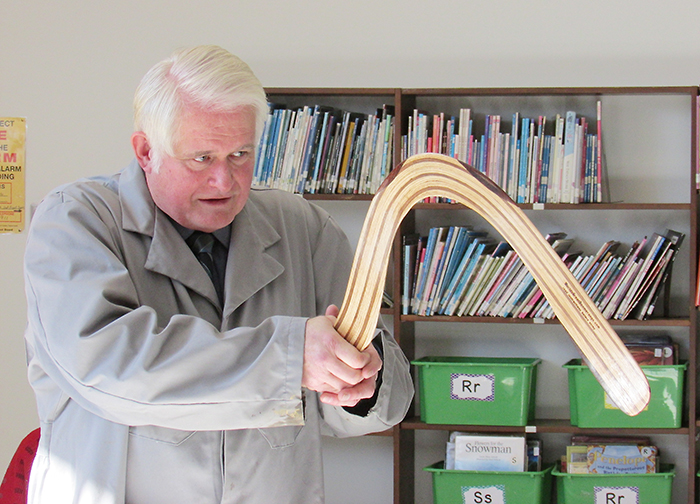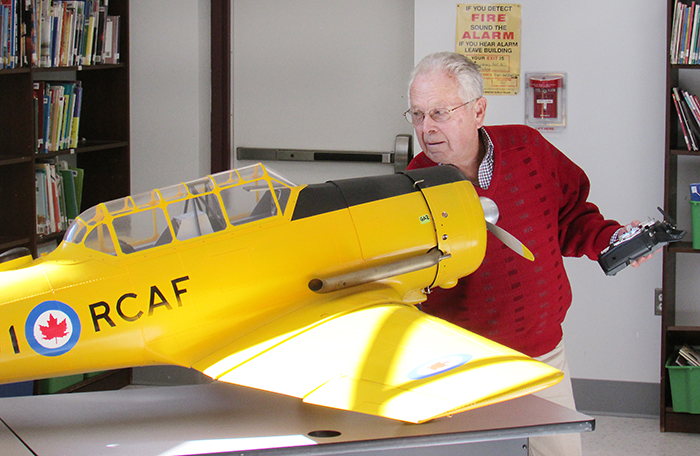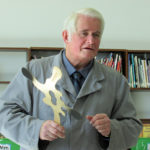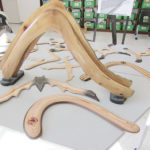
Local boomerang designer and builder John Cryderman demonstrates the proper technique for throwing a boomerang, one he designed and built himself. Cryderman and remote-control plane enthusiast Peter Dick spoke to a Grade 6 class at Queen Elizabeth II School in Chatham recently during their unit on the principles of flight.
When teaching kids about theories behind flight, a more concrete “hands-on” approach can be the most effective – and the most fun.
For Diane Duncan’s Grade 6 class at Queen Elizabeth II School in Chatham, fun and learning came in the form of comparing boomerangs to an airplane’s wings to show how lift and thrust work to make something fly.
Local businessman John Cryderman, with remote control plane enthusiast Peter Dick, brought several styles of boomerangs and a one-fifth scale remote control Harvard airplane to Duncan’s class recently to demonstrate the similar design of airplane wings and boomerangs – based on the Bernoulli Principle.
Cryderman explained how the shape of the wing – an airfoil – is curved at the top, just like a boomerang, and flat on the bottom. Air flowing over the top of the wing travels faster and exerts less pressure, while the underside of the wing is flat and the air travels slower, creating more pressure.
“Air travels fast on top of the wing and slower on the bottom meaning more pressure underneath pushes up and gives us lift,” Cryderman noted. “The same principle applies for boomerangs.”
The local businessman has been designing and selling boomerangs all over the world for about 30 years, and currently has more than 300 designs to his credit. In his own personal collection, Cryderman admitted he has about 5,000 boomerangs, including museum-quality pieces that date back to the time of Egyptian pharaohs. He has traveled Canada extensively lecturing about the aerodynamics of boomerangs, including a trip to the Edmonton Space Centre.
The class asked several questions about how he comes up with his designs and the cost of boomerangs to make. Picking up one design to show the class that looked similar to an ink blob, he described his design process.
“You see this design? I came up with this one day when I was carrying a cup of water and some spilled over the edge and fell on the floor creating a water splat. That is how I came with what you see here,” he laughed as he explained to the class.
With the advantage of having a scaled version airplane right in the class to compare to the boomerang shape, the duo was able to visually demonstrate how an airfoil works. With planes, an engine provides the thrust; with boomerangs, Cryderman said the power comes from the force and angle of the throw.
“Boomerangs create their own lift powered by the person throwing it,” he said.
He demonstrated the proper throwing technique to the class and passed around examples of his work, including boomerangs shaped like a bat, a spider and four-winged throwing stars. He also let the class see and handle examples of his more elaborate and expensive designs that include inlaid exotic woods and precious metals such as silver and gold.
When asked about the costs, he said his boomerangs range in price from $25 to a set he custom-designed for England’s Prince Charles that is worth approximately $27,000.

Dick demonstrated how the wings on the Harvard replica worked, a plane built in incredible detail by his friend Peter Prisner, who fell ill and died before the could finish the project. Prisner’s family entrusted the plane to Dick to finish, who painted it in the style of an RCAF Harvard planes used to train pilots during the Second World War.
Down to the application of glue dots to simulate rivets, Dick said the plane can travel up to 80 km/h and trails smoke, just like the original Harvards.









